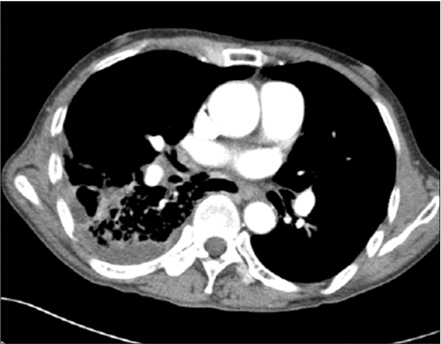Tuberc Respir Dis.
2013 Jun;74(6):286-290.
Cerebral Air Embolism Following Pigtail Catheter Insertion for Pleural Fluid Drainage
- Affiliations
-
- 1Department of Internal Medicine, Hanmaeum Hospital, Changwon, Korea.
- 2Department of Internal Medicine, Hanyang University College of Medicine, Seoul, Korea. hjyoon@hanyang.ac.kr
Abstract
- Pigtail catheter drainage is a common procedure for the treatment of pleural effusion and pneumothorax. The most common complications of pigtail catheter insertion are pneumothorax, hemorrhage and chest pains. Cerebral air embolism is rare, but often fatal. In this paper, we report a case of cerebral air embolism in association with the insertion of a pigtail catheter for the drainage of a pleural effusion. A 67-year-old man is being presented with dyspnea, cough and right-side chest pains and was administered antibiotics for the treatment of pneumonia. The pneumonia failed to resolve and a loculated parapneumonic pleural effusion developed. A pigtail catheter was inserted in order to drain the pleural effusion, which resulted in cerebral air embolism. The patient was administered high-flow oxygen therapy and recovered without any neurologic complications.
Keyword
MeSH Terms
Figure
Reference
-
1. Horsley A, Jones L, White J, Henry M. Efficacy and complications of small-bore, wire-guided chest drains. Chest. 2006; 130:1857–1863.2. Lin CH, Lin WC, Chang JS. Comparison of pigtail catheter with chest tube for drainage of parapneumonic effusion in children. Pediatr Neonatol. 2011; 52:337–341.3. Gammie JS, Banks MC, Fuhrman CR, Pham SM, Griffith BP, Keenan RJ, et al. The pigtail catheter for pleural drainage: a less invasive alternative to tube thoracostomy. JSLS. 1999; 3:57–61.4. Muth CM, Shank ES. Gas embolism. N Engl J Med. 2000; 342:476–482.5. Bou-Assaly W, Pernicano P, Hoeffner E. Systemic air embolism after transthoracic lung biopsy: a case report and review of literature. World J Radiol. 2010; 2:193–196.6. Light RW. Pleural controversy: optimal chest tube size for drainage. Respirology. 2011; 16:244–248.7. Havelock T, Teoh R, Laws D, Gleeson F. BTS Pleural Disease Guideline Group. Pleural procedures and thoracic ultrasound: British Thoracic Society Pleural Disease Guideline 2010. Thorax. 2010; 65:Suppl 2. ii61–ii76.8. Miller KS, Sahn SA. Chest tubes: indications, technique, management and complications. Chest. 1987; 91:258–264.9. Poncia H, Ryan JM. An unusual complication of chest tube thoracostomy. CJEM. 2000; 2:121–123.10. Ho AM, Ling E. Systemic air embolism after lung trauma. Anesthesiology. 1999; 90:564–575.11. Westcott JL. Air embolism complicating percutaneous needle biopsy of the lung. Chest. 1973; 63:108–110.12. Um SJ, Lee SK, Yang DK, Son C, Kim KN, Lee KN, et al. Four cases of a cerebral air embolism complicating a percutaneous transthoracic needle biopsy. Korean J Radiol. 2009; 10:81–84.13. Hare SS, Gupta A, Goncalves AT, Souza CA, Matzinger F, Seely JM. Systemic arterial air embolism after percutaneous lung biopsy. Clin Radiol. 2011; 66:589–596.14. Ohashi S, Endoh H, Honda T, Komura N, Satoh K. Cerebral air embolism complicating percutaneous thin-needle biopsy of the lung: complete neurological recovery after hyperbaric oxygen therapy. J Anesth. 2001; 15:233–236.
- Full Text Links
- Actions
-
Cited
- CITED
-
- Close
- Share
- Similar articles
-
- Tension hydrothorax induced by malposition of central venous catheter: A case report
- Stroke Caused by Cerebral Air Embolism after Central Venous Catheter Removal: A Case Report
- A Case of Cerebral Air Embolism after Removal of Subclavian Venous Catheter
- The evaluation of image-guided catheter drainage in pleural effusion and empyema
- Cerebral Air Embolism Following a Gastroscopy



